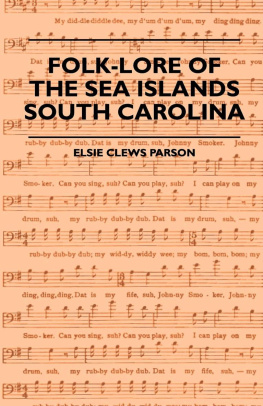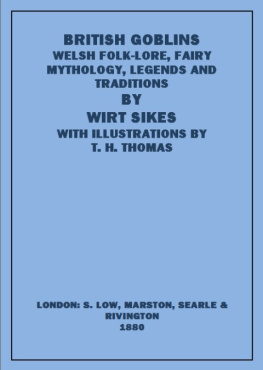Title: A Study in Tinguian Folk-Lore
Author: Fay-Cooper Cole
Release Date: December, 2004 [EBook #7017] [Yes, we are more than one year ahead of schedule] [This file was first posted on February 23, 2003]
Edition: 10
Language: English
A STUDY IN TINGUIAN FOLK-LORE
By
FAY-COOPER COLE
Submitted in partial fulfilment of the requirements for the Degree of
Doctor of Philosophy, in the Faculty of Philosophy, Columbia University
Chicago
1915
A STUDY IN TINGUIAN FOLK-LORE
This paper is based on a collection of Philippine folk-tales recently published by the Field Museum of Natural History. [1] The material appearing in that publication was gathered by the writer during a stay of sixteen months with the Tinguian, a powerful pagan tribe inhabiting the mountain districts of Abra, Ilocos Sur, and Norte, of Northern Luzon. In social organization, government, manner of house building, and many other details of material culture this tribe differs radically from the neighboring Igorot. Observation has also led me to the conclusion that the religious organization and ceremonies of this people have reached a higher development than is found among the near-by tribes, and that this complexity decreases as we penetrate toward the interior or to the south. In the main the folk-tales are closely associated with the religious beliefs of the present day, and hence it seems unlikely that they will be found, in anything approaching their present form, far outside the districts dominated by this tribe. Nevertheless, isolated incidents corresponding to those of neighboring peoples, or even of distant lands, occur several times.
In the following pages an attempt has been made to bring together the culture of this people, as it appears in the myths, and to contrast it to present day conditions and beliefs. In this way we may hope to gain a clearer insight into their mental life, and to secure a better idea of the values they attach to certain of their activities than is afforded us by actual observation or by direct inquiry. It is also possible that the tales may give us a glimpse of the early conditions under which this people developed, of their life and culture before the advent of the European.
It should be noted at the outset that no attempt is here made to reconstruct an actual historical period. As will appear later, a part of the material is evidently very old; later introductionsto which approximate dates may be assignedhave assumed places of great importance; while the stories doubtless owe much to the creative imaginations of successive story tellers.
For the purposes of our study, the tales have been roughly divided into three parts. The first, which deals with the mythical period, contains thirty-one tales of similar type in which the characters are for the most part the same, although the last five tales do not properly fit into the cycle, and the concluding story of Indayo is evidently a recent account told in the form of the older relations.
In the second division are the ritualistic and explanatory myths, the object of which seems to be to account for the origin of or way of conducting various ceremonies; for the belief in certain spirits and sacred objects; for the existence of the sun, moon, and other natural phenomena; for the attainment of fire, food plants, birds and domestic animals, as well as of magical jars and beads. Here it should be noted that some of the most common and important beliefs and ceremonies are, so far as is known, unaccompanied by any tales, yet are known to all the population, and are preserved almost without change from generation to generation.
Division three contains the ordinary stories with which parents amuse their children or with which men and women while away the midday hours as they lounge in the field houses, or when they, stop on the trail to rest and smoke.
None of the folk-tales are considered as the property of the tellers, but only those of the third division are well known to the people in general. Those of the first section are seldom heard except during the dry season when the people gather around bonfires in various parts of the village. To these go the men and women, the latter to spin cotton, the former to make fish nets or to repair their tools and weapons. In such a gathering there are generally one or more persons who entertain their fellows with these tales. Such a person is not paid for his services, but the fact that he knows "the stories of the first times" makes him a welcome addition to the company and gives him an enviable position in the estimation of his fellows.
The purely ritualistic tales, called diams, are learned word by word by the mediums, [2] as a part of their training for their positions, and are only recited while an animal is being stroked with oil preparatory to its being sacrificed, or when some other gift is about to be presented to the superior beings. The writer has recorded these diams from various mediums in widely separated towns and has found them quite uniform in text and content. The explanatory tales were likewise secured from the mediums, or from old men and women who "know the customs." The stories of the last division are the most frequently heard and, as already indicated, are told by all. It is evident even to the casual reader that these show much more evidence of outside influence than do the others; some, indeed, appear to have been recently borrowed from the neighboring christianized Ilocano. [3]
TALES OF THE MYTHICAL PERIOD
Reconstruction of the Culture.In the first division certain actors occur with great frequency, while others always take the leading parts. These latter appear under a variety of names, two or more titles often being used for the same individual in a single tale. To avoid confusion a list of the fourteen principal actors and their relationships are given in the accompanying table. It will appear that there are some conflicts in the use of names, but when it is realized that the first twenty-six myths which make up the cycle proper were secured from six story tellers coming from four different towns, the agreement rather than the disagreement is surprising. As a matter of fact there is quite as much variation between the accounts of the same narrator as between those gathered from different towns.
TABLE OF LEADING CHARACTERS [4]
I. Aponitolau. Son of Pagatipnan [male] and Langa-an [female] [5] of Kadalayapan; is the husband of Aponibolinayen. Appears under the following names: (a) Ligi, (b) Albaga of Dalaga, (c) Dagdagalisit, (d) Ingiwan or Kagkagkag, (e) Ini-init, (f) Ling-giwan, (g) Kadayadawan, (h) Wadagan, (i) Awig (?)
II. Aponigawani. Sister of Aponitolau and wife of Aponibalagen.
III. Aponibolinayen. Daughter of Pagboksan [6] [male] and Ebang [female] of Kaodanan. Wife of Aponitolau. Appears as (a) Ayo, (b) Dolimman (?).
IV. Aponibalagen. Brother of Aponibolinayen, and husband of
Aponigawani; also appears as Awig.
V. Kanag. Son of Aponitolau and Aponibolinayen. Appears as (a) Kanag kabagbagowan, (b) Balokanag, (c) Dumanau, (d) Ilwisan, (e) also at times is identified with Dumalawi, his brother.
VI. Dapilisan, wife of Kanag.
VII. Dagolyan. Son of Aponibalagen and Aponigawani. Also appears as
Dondonyn of Bagonanthe blood clot child.
VIII. Alokotn. An old woman who acts as a medium. Her home is at Nagbotobotn, where the rivers empty their waters into the hole at the edge of the world.
IX. Gawigawen [male]. A giant who owns the orange trees of Adasin.





